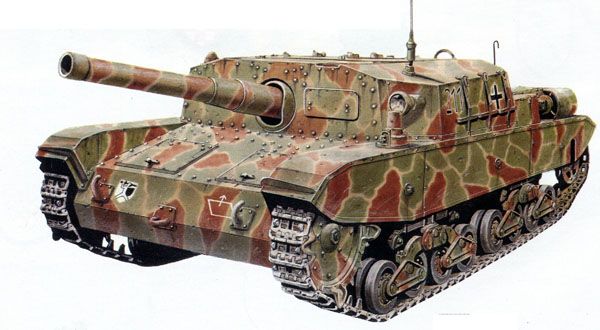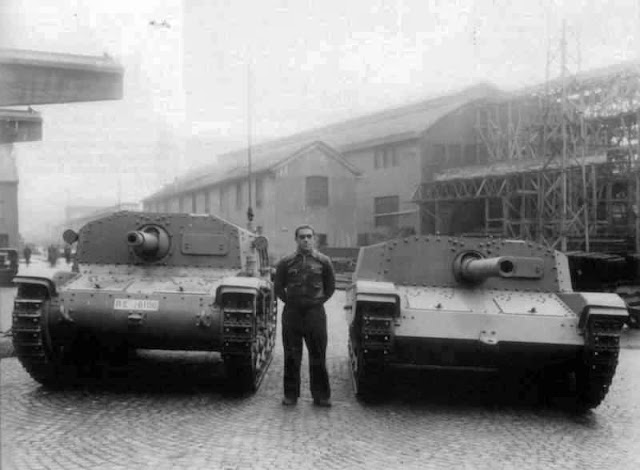Il Fiat - Ansaldo 105/25 M.43, noto anche come Semovente da 105/25, è stato un semovente italiano utilizzato durante la seconda guerra mondiale e progettato dalla Fiat-Ansaldo, considerato uno dei più potenti semoventi costruiti dall'Italia nel secondo conflitto mondiale.
Storia
Lo sviluppo di un semovente di grande potenza fu realizzato durante il 1942 in parallelo dalla Odero-Terni-Orlando (OTO) e dalla Ansaldo. La OTO propose l'installazione di un 105/23 sullo scafo di un carro armato P26/40. L'Ansaldo invece propose come scafo quello del semovente M42 già in produzione e fu in grado quindi di presentare, il 28 febbraio 1943, il prototipo al Centro Studi della Motorizzazione mentre la OTO era ancora impegnata nello sviluppo. Venne perciò prescelto dal Regio Esercito e la versione definitiva, con scafo migliorato e cannone da 105/25 (in luogo di quello da 23 calibri di lunghezza), fu adottata in 878 esemplari il 2 aprile 1943 come Semovente M43 da 105/25 "Bassotto". Dodici esemplari vennero costruiti e utilizzati nel 1943 dalla 135ª Divisione corazzata "Ariete II", che si scontrò con le truppe tedesche nei pressi di Roma nei giorni successivi all'armistizio attuato dal governo italiano, l'8 e il 9 settembre 1943, dando un'ottima prova di sé. A seguito della resa italiana, i tedeschi, che consideravano i semoventi 105/25 degli ottimi mezzi, li catturarono e ne costruirono ulteriori 91 esemplari, ribattezzati StuG M43 mit 105/25 853 utilizzandoli contro le forze anglo-americane. A cavallo del 1944-45, un esemplare fu anche adoperato dal Gruppo Corazzato "Leoncello" della RSI nei pressi di Brescia.
Il cannone da 105/25 fu anche postato in casamatta nelle opere difensive del Vallo Alpino.
Tecnica
Il "Bassotto", ricalcando l'impostazione generale del predecessore M42, era costituito da uno scafo M43, cioè lo scafo di un carro armato M15/42 allargato e abbassato, con frontale ridisegnato e lamiere laterali saldate invece che imbullonate. Sullo scafo era posta una casamatta fissa imbullonata e saldata con un obice Ansaldo 105/25, con brandeggio manuale di 34° ed alzo da -12° a + 22°. L'armamento era completato da una mitragliatrice Breda Mod. 38 da 8 mm per la difesa ravvicinata ed antiaerea operata dal capocarro/cannoniere, mentre il servente/operatore radio ha a disposizione per le comunicazioni a livello di batteria di una radio Magneti Marelli RF1 CA.
Versioni
Semovente M43 da 75/34
Versione concepita dall'Ansaldo che, al posto del cannone da 105/25, montava il cannone da 75/34 Mod. S.F. già installato sul semovente da 75/34; fu definita StuG M43 mit 75/34 (851) dai tedeschi. Fu fabbricato in soli ventitré o ventinove esemplari nel 1944 e fu impiegato dal solo esercito tedesco.
Semovente M43 da 75/46
Sviluppata dall'Ansaldo nel 1944 e designata dai tedeschi StuG M43 mit 75/46 (852) per i tedeschi, era una versione cacciacarri basata su scafo pesantemente modificato dell'M.43 da 105/25. Era l'ultimo cingolato prodotto in Italia e solo dopo l'8 settembre 1943, oltre a essere il primo costruito prevalentemente con lamiere saldate e non solo imbullonate. Venne anche pensato di utilizzare materiali alternativi (calcestruzzo rinforzato con pietrisco) per integrare la corazzatura, che però poi fu costruita in maniera convenzionale ma con spessori più generosi (massimo frontale 100 mm) rispetto agli altri carri prodotti in Italia. L'armamento consisteva nel cannone antiaereo 75/46 C.A. Mod. 1934/Mod. 40 con quarantadue munizioni, anche se non si fece in tempo a sviluppare una granata specifica per l'impiego controcarro, impiegando una normale spoletta ritardata per migliorare le capacità perforanti. Il brandeggio era manuale su supporto sferico e permetteva un alzo da -12° a +22° ed un brandeggio laterale di 34°. Integrava l'armamento una mitragliatrice Breda Mod. 38 da 8 mm con 500 cartucce, anche se nell'uso fu sovente rimpiazzata da una MG 42 con un maggior numero di proiettili. L'equipaggio era limitato a sole tre persone, lasciando un carico di lavoro eccessivo al capocarro facente funzione di cannoniere, mentre il caricatore era anche mitragliere/radiotelegrafista. Il semovente fu prodotto in undici esemplari (otto nel 1943, tre nel 1944) e adoperato solo dall'esercito tedesco. Uno o due ulteriori mezzi rimasero incompleti o forse furono terminati a ridosso della liberazione, che impedì la ripresa della fabbricazione pianificata per il 1945.
ENGLISH
The Fiat - Ansaldo 105/25 M43, also known as Semovente 105/25, was an Italian self-propelled gun used during World War II and designed by Fiat-Ansaldo. It was the most powerful self-propelled gun built by Italy in numbers during World War II.
History
The development of a self-propelled gun with high firepower was initiated during 1942 in parallel by Odera-Terni-Orlando (OTO) and Ansaldo. OTO proposed the installation of a 105/25 gun on the hull of a P26/40 tank. Ansaldo, for its part, proposed to use the hull of the Semovente M42 already in production and was therefore able to present, on 28 February 1943, its prototype to the Centro Studi della Motorizzazione while the OTO model was still in development.
The production of the Ansaldo proposal was therefore approved by the Royal Italian Army. In the final version, with improved hull and the 105/25 gun, it was adopted on April 2, 1943 as the self-propelled M43 105/25, Bassotto ("Dachshund"). The first units to the equipped with the Bassotto were the DCI and DCII groups of the 235th Semoventi Artillery Regiment of the 135ª Armored Division "Ariete II". Each group received twelve units, which were used in the defense of Rome in the days following the armistice of Cassibile that went into effect on 8 and 9 September 1943. They acquitted themselves well in combat.
Following the Italian surrender, the Germans, who regarded the Semovente 105/25 "Bassotto" as a very good vehicle, captured them and built an additional 91 units, renamed StuG M43 mit 105/25 853 and used them against the Anglo-American forces.
The 105/25 cannon was also used in bunkers in the defensive fortifications of the Vallo Alpino.
Features
The Bassotto, modeled on the general design of the M41 and M42 predecessors, consisted of one M43 hull, i.e. the hull of a M15/42 tank widened and lowered, with redesigned front and side plates that were welded instead of bolted. On the hull was placed a fixed casemate bolted and welded with an Ansaldo 105/25 howitzer, with traverse and elevation up to 34 ° -12 ° to + 22 °.
The main armament was complemented with a Breda 38 8 mm machine gun for close and anti-aircraft defense operated by the commander / gunner, while the radio operator had one Magneti Marelli radio RF1 CA.
Versions
Semovente M43 da 75/34
Designed by Ansaldo, this version mounted the 75/34 Mod. S.F. gun used on the semovente 75/34 M42M. It was designated StuG M43 mit 75/34 (851) by the Germans. It was manufactured in only twenty-three and twenty-nine units in 1944 and was only employed by the German army.
Semovente M43 da 75/46
Developed by Ansaldo in 1944 and designated StuG M43 mit 75/46 (852) (i) by the Germans, it was a tank destroyer version based on heavily modified hull of M.43 105/25. It was the last tank destroyer manufactured in Italy after the armistice, as well as being the first Italian AFV with a predominantly welded construction and not bolted. Using alternative materials (concrete reinforced with gravel) was also considered for integration with the armor, but instead it was built conventionally with thicker armor (up front 100 mm) compared to other tanks produced in Italy.
The armament consisted of a re-purposed antiaircraft gun, the 75/46 C.A. Mod. 1934 / Mod. 40, with a load of forty two rounds. Designers did not have time to develop a specialized antitank round, so they employed a normal delayed fuze to improve the penetration capability. The gun laying was manual on a spherical support and allows elevation from -12 ° to + 22 ° and a 34 ° lateral tilt. The armament also included a Breda 38 machine gun with 500 rounds, which was in practice often replaced by a MG 42 with a greater number of rounds. The crew was limited to just three people, leaving a heavy load to the commander acting as gunner, while the loader was also gunner / radio operator. The Semovente was produced in eleven units (eight in 1943, three in 1944) and only used by the German army. One or two additional vehicles were incomplete or perhaps were completed after the liberation of Italy that prevented the restart of the manufacture planned for 1945.
(Web, Google, Wikipedia, You Tube)























Nessun commento:
Posta un commento
Nota. Solo i membri di questo blog possono postare un commento.